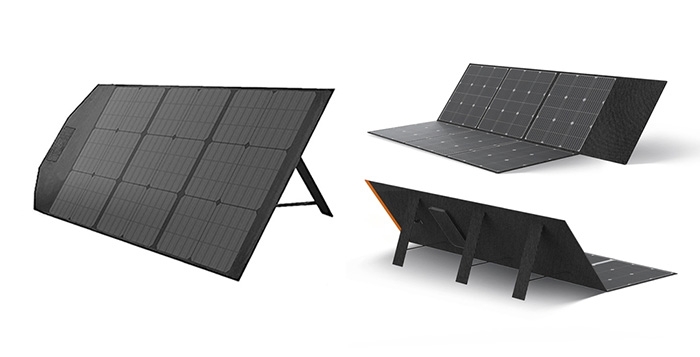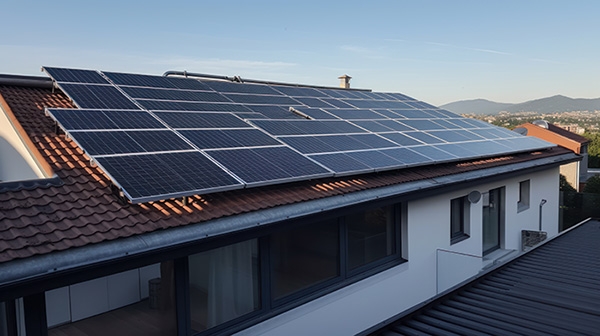Solar panels are devices that convert solar energy into electrical energy and are widely used in homes, businesses, and industries. Choosing high-quality solar panels is crucial for users because it directly affects the power generation efficiency, lifespan, and safety of the solar system. In the market, there are many brands and models of solar panels with large price differences. How to choose a quality solar panel can be a challenging task for novice users. Today Inverter.com will present you with 4 steps to selecting good-quality solar panels.
Observe the appearance
The appearance of a photovoltaic panel can be an important criterion for judging quality. If there is no problem with the appearance of the PV panel, it is likely that its internal structure and materials are also good. When observing the appearance of a solar PV panel, Inverter Online Shop will provide you with the following points to pay attention to:
- Battery Cell Appearance: Observe whether the surface of the battery cell is intact and whether there are chipped edges / chipped corners/lobes/oxidized and other phenomena. An intact cell surface reduces energy loss and improves the power generation efficiency of the solar panel. The presence of obvious chipped edges and oxidized pads on the surface of the cell may be due to problems in manufacturing, and such PV panels may result in insufficient power or reduced lifespan.
- Color: Observe whether the color of the photovoltaic panel is uniform, whether there is a color difference, and other phenomena. The uniform color on the surface of the solar panel indicates that its production quality is relatively stable. The existence of uneven color on the surface of PV panels may be caused by the different grades/batches of battery cells and the lack of consistent testing of battery cells during production, which will lead to the poor appearance of such photovoltaic panels and may lead to a reduction in the service life of the solar energy panels. By observing the appearance of solar panels, we can initially understand the quality of PV panels. Of course, the surface observation does not fully represent the quality of solar panels, we need to combine it with other judgment criteria to make a comprehensive assessment.
Check the logo
When purchasing photovoltaic panels, it is very important to check the markings on the panels. These markings can help you quickly determine the brand, model, and certification of the PV panel for selection and comparison.
- Brand identity (manufacturer or brand name of solar array)
- Model identification (solar panel model or specifications)
- Certification mark (certification standard passed by the solar energy panel, such as TUV certification, IEC certification, CE certification, etc.)
If the solar PV panel does not have the above markings, then you need to pay special attention to its quality and performance. Some solar power panel brands may have labels on the surface or back showing some important parameters of their products, such as voltage, current, power, etc. If these parameters are available, they can be measured to verify whether they meet the performance requirements of the photovoltaic panel.

Measuring parameters
The performance of solar panels can be assessed by measuring several electrical parameters. When selecting PV panels, you can evaluate their performance by measuring the open-circuit voltage (Voc), short-circuit current (Isc), maximum power point voltage (Vmp), and maximum power point current (Imp). Here are the steps to do so:
- Prepare the tools: You will need a multimeter, safety gloves, and a solar array.
- Measure the open-circuit voltage (Voc): Set the multimeter to the DC voltage mode, connect the positive and negative leads to the corresponding terminals on the solar energy panel, and read the displayed value.
- Measure the short-circuit current (Isc): Set the multimeter to the DC current mode, connect the positive and negative leads to the corresponding terminals on the solar panel, and read the displayed value.
- Measure the maximum power point voltage (Vmp) and current (Imp): Connect a variable resistor (load) to the panel, adjust the resistor until the reading on the multimeter is at its maximum, and note the voltage as Vmp and the current as Imp.
When measuring parameters, follow safety guidelines such as wearing safety gloves to prevent electric shock. If the measured results match the manufacturer's specifications, it indicates that the photovoltaic panel has stable performance and is of good quality.
Understand the materials of solar panels
- Types and characteristics of silicon wafers
Currently, the market offers three main types of silicon wafers: monocrystalline silicon, polycrystalline silicon, and amorphous silicon.
Monocrystalline silicon panels: These are made from the highest quality silicon wafers, offering superior efficiency and longer lifespan compared to polycrystalline and amorphous silicon.
Polycrystalline silicon panels: These have slightly lower efficiency and lifespan than monocrystalline panels but are more affordable.
Amorphous silicon panels: These panels have the lowest efficiency and lifespan but are the most cost-effective.
For home photovoltaic projects, it is recommended to use monocrystalline silicon panels due to their higher efficiency and longer lifespan. Currently, the 30W portable solar panels sold online at Inverter.com are cost-effective and can be paired with a 100W portable solar generator and operate within a temperature range of -40°C to 70°C.
- Types and characteristics of glass
Solar panels typically use ultra-clear tempered glass, which is generally 3.2mm thick with a light transmittance of over 90%, providing excellent heat resistance and corrosion resistance. However, some inferior products use thinner, lower-quality green glass, which reduces light transmittance by about 30%, affecting the panel's efficiency and making it more prone to breaking. It is advisable to choose solar energy panels made with ultra-clear tempered glass to ensure high efficiency and long lifespan.
- Types and characteristics of aluminum frames
Solar panels usually employ anodized aluminum frames, known for their high thickness and hardness, making them resistant to deformation and detachment. In contrast, some inferior products use recycled materials for the frames, which significantly reduce their thickness and hardness, making them prone to deformation and detachment. It is recommended to choose solar arrays with anodized aluminum frames to ensure stability and longevity.
- Encapsulation materials
Encapsulation materials are a crucial component of solar panels, typically made from EVA (ethylene-vinyl acetate). The primary function of EVA is to bond the solar cells to the glass panel, protecting the cells from environmental factors and enhancing the panel's conversion efficiency. Generally, two or more layers of EVA are used to ensure sufficient bonding strength and waterproofing. Using low-quality EVA or a single layer can shorten the panel's lifespan, cause cell delamination, or lead to corrosion, impacting the panel's performance and durability. Therefore, when purchasing solar panels, select products with high-quality encapsulation materials to ensure the panel's quality and longevity.

Choosing quality solar energy products, such as a solar array for home use, requires a combination of appearance, labeling, performance parameters, and materials. In addition, it is also very helpful to refer to the experience of other users and consult professionals.
- Understand the local climate and weather conditions. The power generation efficiency and lifespan of PV panels are affected by weather and climate. Therefore, understanding the local climate and weather conditions is crucial for choosing photovoltaic panels. For example, the lifespan of solar panels may be affected under high temperatures and humidity, so it is important to choose solar energy panels suitable for local climate conditions.
- Refer to the experience of other users. Asking other users of solar arrays for their reviews and feedback on different brands and models of PV panels is also very helpful. You can look for other users' experiences on solar PV sellers, installers, internet forums, and other channels.
- Seek advice from professionals. It is also very important to seek advice from solar system installers, electricians, or other professionals. They can provide advice on the performance of photovoltaic panels, suitable sizes, models, installation locations, and so on. Also, ask for their reviews and feedback on different brands and models of solar panels.
So how to choose a quality solar panel? It is necessary to consider many aspects, including appearance, logo, performance parameters, and materials, and refer to the experience and professional opinions of other users. This will ensure that you are purchasing an efficient and durable solar array that optimizes the overall performance of your solar system.
